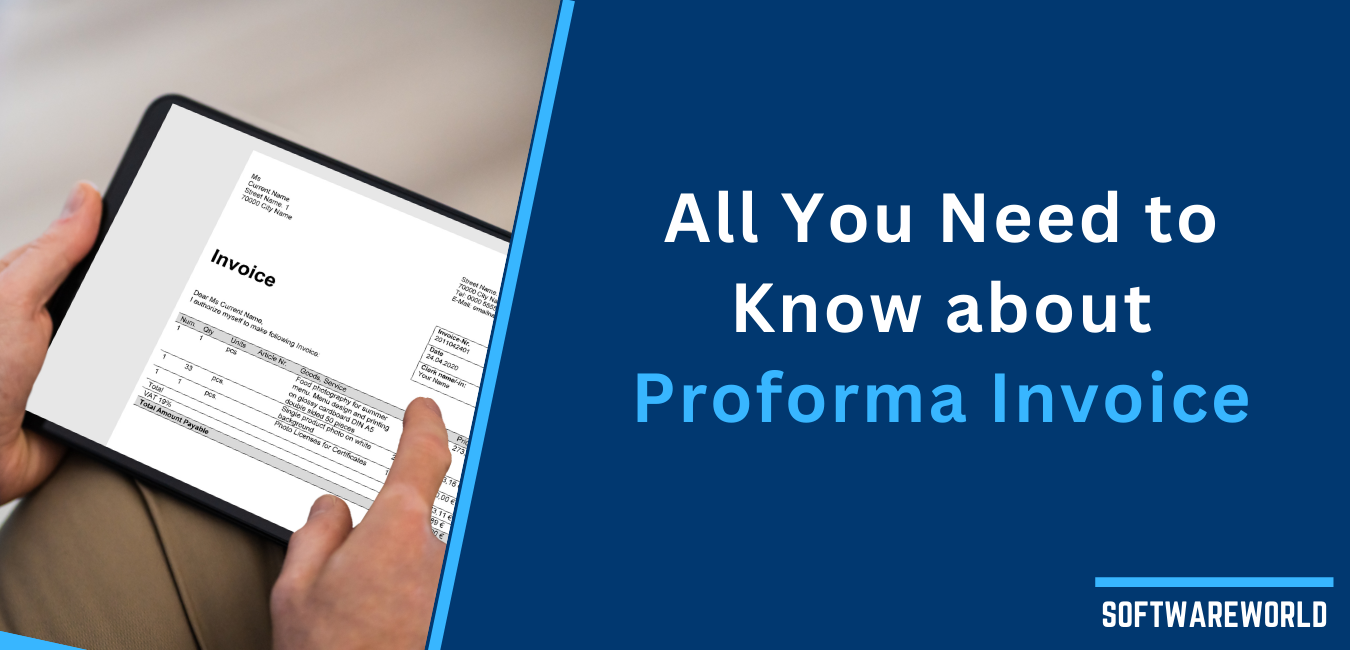Picture this.
You’re done negotiating the terms of a deal with this new client. And that client has asked you to send a pro forma, leaving you scratching your head!
Before you start questioning your decision to start a business and handling it all on your own, let us tell you there is a lot of confusion about pro forma bills. Not just in the first-time entrepreneurs but also among the established business owners.
Width: 1024px, Height: 647px
Width: 0px, Height: 0px
This article clarifies the most common and essential concepts surrounding pro forma invoices — what they are, why and when you should use them, what to include in a proforma, and much more.
So, let’s dive in deeper to understand.
A pro forma invoice is also known as a proforma invoice, a preliminary invoice, a good faith agreement, or a proforma. Its meaning in Latin refers to “for the sake of form.” A pro forma invoice is not a real-world or actual invoice. Think of it as a bill of sale for goods or services that are yet to be delivered or fulfilled.
A pro forma invoice is sent to the client after the negotiation of a deal to ensure both parties remain on the same page. It acts as a temporary agreement between you and your client with essential details such as requested services or goods, the type of services or shipping information, terms, pricing, and timelines.
It is only after the client green lights the pro forma bill that you, the business, start the order fulfillment process. Upon order completion, you’d share a final formal invoice with the client.
It is important to note that proforma holds no value in the books of accounts. It is not a document to raise a payment request. It is more of a detailed quote to avoid disputes between the parties in the future.
The purpose of a pro forma bill is to streamline your sales process, as well as internal operations and communication. Through a proforma, you enable the clients to know ahead of time what exactly to expect about the deal. From the timelines of the goods or services to the costs and terms, such bills cover it all.
The best thing? Customers can ask for modifications to the terms of a proforma, such as a change to the delivery date or pricing of the goods/services.
That way, proformas help prevent the scope of conflicts and misunderstandings between a seller and a buyer. Both at the time of or post the delivery of goods/services.
Let’s say you are a wholesaler of stationary supplies. You’ve received a bulk order for 500 notebooks and 350 geometry boxes. You start the order fulfillment process without any formal confirmation. And after, say, two weeks, you dispatch the order, along with the invoice. But the client is dissatisfied because of one or more of the following reasons:
- They wanted products from a different brand
- They wanted to change the order quantity
- They found the pricing too high
- They expected more flexible payment terms
In such a scenario, it is tedious to modify the sales invoice to accommodate client demands every time you do business. That’s when creating a proforma invoice comes in handy.
As soon as you receive an order, you create a proforma bill covering all the required order details, including the costs, quantity, delivery dates, and payment terms. Your client can go through this preliminary bill and negotiate if necessary. Upon arriving on mutually agreeable terms, you send this good faith agreement to the client and begin fulfilling the order. Once you complete the order, you can simply convert the proforma invoice into a commercial sales invoice.
The above scenario underlines the benefits of using proforma invoices as a business. To sum it up, we can say that a pro forma invoice helps organizations:
- Establish clear expectations and terms of service with clients
- Showcase their intent to fulfill the order as per the agreed terms
- Make clients feel valued by giving them more room for negotiation
- Get an assurance of order confirmation from the clients
- Streamline the internal purchase process for the clients
- Streamline their internal sales process
- Save time, costs, and effort that goes into order processing
- Build a strong professional image, boosting client trust
A preliminary invoice is issued to the client before delivering the goods or services. However, don’t forget that you must only send a final pro forma invoice when you’re done negotiating the deal.
In other words, a final pro forma bill is nothing but a confirmation of the order, highlighting the pre-agreed terms. You send it out after shaking hands on the deal but before beginning the order fulfillment process.
Businesses the world over tend to rely on pro forma invoices in the following cases:
Global Trades and Imports
A pro forma invoice simplifies the customs process for businesses into imports and trades across the globe. Furnishing a precise summary of the products is a must for global shipments. And since these bills include all the required details, such as item value, quantity, weight, and costs, they speed up the customs approval process. As a result, the shipment reaches the client on time, boosting your goodwill.
Custom Orders
Width: 990px, Height: 610px
Width: 990px, Height: 610px
Width: 990px, Height: 610px
Width: 0px, Height: 0px
Pro forma invoices come in handy for manufacturing firms that fulfill personalized orders, especially in bulk. These bills act as an assurance that the customer won’t back out last moment, citing conflicts in the terms of goods/services. That, in turn, helps you maximize your time and resources, resulting in faster order fulfillment.
Pro forma invoices come in handy for manufacturing firms that fulfill personalized orders, especially in bulk. These bills act as an assurance that the customer won’t back out last moment, citing conflicts in the terms of goods/services. That, in turn, helps you maximize your time and resources, resulting in faster order fulfillment.
Although a pro forma bill is not a sales invoice, it must consist of certain information about the deal for the benefit of both the involved parties. Unlike a formal sales invoice, it is not necessary for a preliminary agreement to have an invoice number.
What’s interesting is, proformas can add any essential detail that either of the parties considers relevant.
Things your pro forma invoice should include are as follows:
- A title - “Pro Forma Invoice”
- Your organization name, address, and contact details
- The client’s name, address, and contact details
- Date of issue
- Date of expiration (validity of the proforma invoice)
- Due date (the delivery date of goods/services)
- Order description that includes the details of the requested goods/services
- Total costs of the requested goods/services
- Quantity of the requested goods/services
- Payment terms
- Any additional terms & conditions
- Discounts
- Taxes
Navigating the world of invoices is easier said than done for a newbie entrepreneur. There are so many different types of invoices, after all. It becomes a hassle to understand whether you should send a sales invoice, a proforma invoice, or a commercial invoice in a particular scenario.
To make things a bit simpler, here is the comparison you never asked for but we know you needed all along:
| Comparison | Pro Forma Invoice | Sales Invoice | Commercial Invoice |
| Definition | It’s a preliminary agreement, providing the details of the services/goods to be delivered | A document requesting payment, confirming that the sale has occurred | A document detailing the particulars of the sale with added information necessary for global trade transactions |
| Purpose | To set clear client expectations and terms about the deal | To request payment from the client | To serve as an official record of sale and assess import taxes & duties |
| When to issue? | Before delivering the goods/services | After delivering the goods/services | At the time of shipment |
| Legal status | No legal obligation | Holds legal value as a record of sale/transaction | Provides legal obligation |
| Accounting use | No value in the books of accounts | Valuable in the accounting process | Valuable in the accounting process |
Wondering what an actual pro forma invoice looks like? Here is a template for your reference:

Width: 506px, Height: 427px
Width: 506px, Height: 427px
Width: 506px, Height: 427px
Width: 506px, Height: 427px
Width: 506px, Height: 427px
Width: 0px, Height: 0px
The Final Word
A proforma invoice, as we discovered, is an initial good-faith agreement between the business and its clients outlining the terms of service/sale. It helps provide the clients with an accurate understanding of the order - from the type of goods/services to their quantity, total cost, and delivery timelines.
While it may come across as yet another document to a pile of plenty, it acts as essential evidence for the deal. A proforma invoice helps avert confusion and disputes in the future - at the time of and post the order delivery.
Thankfully, you can get started with the help of proforma templates and tools available online, for instance,
Zoho and
Freshbooks, regardless of your industry. Using these tools helps save time and optimize the entire process.



